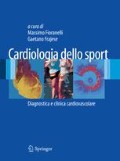Abstract
L’ecocardiografia bidimensionale e color-Doppler rappresenta la metodica di imaging di più ampio utilizzo nella popolazione degli atleti. In questi soggetti l’ecocardiografia rappresenta un valido strumento per la diagnosi di cardiopatie potenzialmente letali. Infatti, negli ultimi anni hanno avuto molta risonanza mediatica degli episodi di morte improvvisa associata all’esercizio fisico in atleti a livello agonistico. Spesso la causa sottostante della morte improvvisa in tali pazienti è rappresentata da alterazioni strutturali cardiache e/o vascolari che possono essere identificate dall’ecocardiografia. La presenza di una cardiopatia può rappresentare un criterio di esclusione da sport agonistici al fine di ridurre il rischio di morte improvvisa e/o può giustificare l’impianto di un defibrillatore automatico. D’altro canto il cuore dell’atleta, e specificatamente il cuore di atleti molto allenati, praticanti sport di resistenza (maratona, nuoto) o misti (sci di fondo, ciclismo e canottaggio), va incontro a delle modificazioni strutturali e funzionali che vanno conosciute al fine di evitare diagnosi errate di cardiopatie. Il presente capitolo ha l’intento di fornire una guida strutturata allo studio ecocardiografico del cuore dell’atleta.
Access this chapter
Tax calculation will be finalised at checkout
Purchases are for personal use only
Preview
Unable to display preview. Download preview PDF.
Bibliografia
AA.VV. (2010) Protocolli cardiologici per il giudizio di idoneità allo sport agonistico 2009. Medicina dello sport 63:5–137
Marron BJ, Pelliccia A (2006) The heart of trained athletes. Cardiac remodeling and risks of sports, including sudden death. Circulation 114:1633–1644
Pelliccia A, Maron BJ, Di Paolo FM et al (2005) Prevalence and clinical significance of left atrial remodeling in competitive athletes. J Am Coll Cardiol 46: 690–696
Pelliccia A, Culasso F, Di Paolo F et al (1999) Physiologic left ventricular cavity dilatation on elite atlete. Ann Intern Med 130:23–31
Pelliccia A, Maron BJ, Spataro A et al (1991) The upper limit of physiologic cardiac hypertrophy in highly trained elite athletes. N Engl J Med 324: 295–301
Marron BJ, Pelliccia A, Spirito P (2005) Cardiovascular disease in young trained athletes. Insights into methods for distinguishing athlete’s heart from structural heart disease, with particular emphasis on hypertrophic cardiomyopathy. Circulation 91:1596–1601
Zeppilli P, Dello Russo A, Santini C et al (1998) In vivo detection of coronary artery anomalies in asymptomatic athletes by echocardiographic screening. Chest 114:89–93
Maron BJ (1986) Structural features of the athletes heart as defined by echocardiography. J Am Coll Cardiol 7:190–203
Schiller NB, Shah PM, Crawford M et al (1989) Recommendations for quantitation of the left ventricle by two-dimensional echocardiography. American Society of Echocardiography Committee on Standards, Subcommittee on Quantitation of Two-Dimensional Echocardiograms. J Am Soc Echocardiogr 2:358–367
Feigenbaum H, Armstrong W, Ryan T. (2005) Feigenbaum’s echocardiography, 6th edn. Lippincott, Williams and Wilkins, Philadelphia
Lang RM, Bierig M, Devereux RB et al (2006) Recommendation for chambers quantification. Eur J Echocardipgraphy 7:79–108
Palmieri V, Dahlof B, DeQuattro V et al (1999) Reliability of echocardiographic assessment of left ventricular structure and function: the PRESERVE study: Prospective Randomized Study Evaluating Regression of Ventricular Enlargement. J Am Coll Cardiol 34:1625–1632
Devereux RB, Alonso DR, Lutas EM et al (1986) Echocardiographic assessment of left ventricular hypertrophy: comparison to necropsy findings. Am J Cardiol 57:450–458
Otto CM, Aurigemma GP, Bartel T et al (2007) The practice of clinical echocardiography, 3th ed. Saunders Elsevier, Philadelphia
Cerqueira MD, Weissman NJ, Dilsizian V et al (2002) Standardized myocardial segmentation and nomenclature for tomographic imaging of the heart: a statement for healthcare professionals from the Cardiac Imaging Committee of the Council on Clinical Cardiology of the American Heart Association. Circulation 105: 539–542
Matsukubo H, Matsuura T, Endo N et al (1977) Echocardiographic measurement of right ventricular wall thickness. A new application of subxiphoid echocardiography. Circulation 56:278–284
Foale R, Nihoyannopoulos P, McKenna W et al (1986) Echocardiographic measurement of the normal adult right ventricle. Br Heart J 56:33–44
Marcus FI, McKenna WJ, Sherril D et al (2010) Diagnosis of arrhythmogenic right ventricular cardiomyopathy/dysplasia proposed modification of the task force Criteria. Circulation 121:1533–1541
Weyman A (1994) Practices and principles of echocardiography, 2nd edn. Lippincott Williams and Wilkins, Philadelphia
Redfield MM, Jacobsen SJ, Burnett Jr JC et al (2003) Burden of systolic and diastolic ventricular dysfunction in the community: Appreciating the scope of the heart failure epidemic. JAMA 289:194–202
Baumgartner H, Hung J, Bermejo J et al (2009) Echocardiographic assessment of valve stenosis: EAE/ASE recommendations for clinical practice. JASE 22:1–23
Lancellotti P, Moura L, Pierard LA (2010) European Association of Echocardiography Recommendations for the assessment of valvular regurgitation. Part 2: mitral and tricuspid regurgitation (native valve disease). Eur J Echocardiogr 11:307–332
Marwick TH (2006) Measurement of strain and strain rate by echocardiography Ready for prime time? J Am Coll Cardiol 47:1313–1327
Mondillo S, Galderisi M, Mele D et al (2011) Speckle-tracking echocardiography: a new technique for assessing myocardial function. J Ultrasound Med 30:71–83
Caso P, D’Andrea A, Galderisi M et al (2000) Pulsed Doppler Tissue imaging in endurance athletes: Relation between left ventricular preload and myocardial regional diastolic function. Am J Cardiol 85:1131–1136
Palka P, Lange A, Donnelly JE et al (2000) Differentiation between restrictive cardiomyopathy and constrictive pericarditis by early diastolic Doppler myocardial velocity gradient at the posterior wall. Circulation 102:655–662
Vinereanu D, Florescu N, Schulthorpe N et al (2001) Differentiation between pathologic and physiologic left ventricular hypertrophy by tissue Doppler assessment of long-axis function in patients with hypertrophic cardiomyopathy or systemic hypertension and in athletes. Am J Cardiol 88:53–58
Galderisi M, Lomoriello VS, Santoro A et al (2010) Differences of myocardial systolic deformation and correlates of diastolic function in competitive rowers and young hypertensives: a speckle-tracking echocardiography study. J Am Soc Echocardiogr 23:1190–1198
Author information
Authors and Affiliations
Rights and permissions
Copyright information
© 2011 Springer-Verlag Italia
About this chapter
Cite this chapter
Rizzello, V., Fioranelli, M. (2011). L’ecocardiografia nell’atleta. In: Cardiologia dello Sport. Springer, Milano. https://doi.org/10.1007/978-88-470-2352-9_3
Download citation
DOI: https://doi.org/10.1007/978-88-470-2352-9_3
Publisher Name: Springer, Milano
Print ISBN: 978-88-470-2351-2
Online ISBN: 978-88-470-2352-9
eBook Packages: MedicineMedicine (R0)

